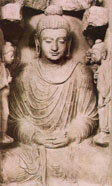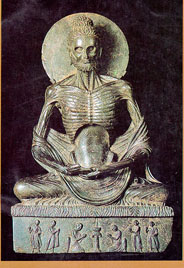Gandhara Civilization

Seated Buddha in Dhayana Mudra
pose from Julian Monastery, Taxila

Fasting Buddha
The Zenith of Gandhara Art !
Finally,
the light of Islam penetrated in this part of the world as early as 7th century AD. from
the west with the Arabs and during the 10th century AD from the north with the Turks.
Islam replaced the early way of life of worshipping idols and introduced new philosophy of
faith in one God. With Islam in came a new culture in this land from Arabia and Central
Asia. Hence, a new type of architecture, hitherto unknown in this area, was introduced.
Tens of thousands of Mosques, Madrassahs, tombs and gardens were created by the Muslim
rulers all over the Sub-Continent. The new style of Islamic architecture prevailed and
matured in this land for over a thousand years. The most important contribution of the
Muslim rulers to this land, however, is a new language ‘Urdu’ which became the
national language of Pakistan since its independence in 1947.
- The legacy of our predecessors at the time of our independence, on August 14, 1947, came to us as a treasure which may be called as Pakistan’s national heritage. So rich and diversified is this heritage that Pakistani nation can be proud of its glorious past, be Islamic, Post Islamic or pre-Islamic period as far back as pre-historic times. It is hard to find another country which can produce the treasure of by gone days as can be found in Pakistan. It is now incumbent upon us to treasure our national heritage and save it from further deterioration and theft.
The establishment of NFCH is much appreciated and a great interest is shown by the general public hence since its establishment in 1994 hundreds of proposals were received from different agencies and individuals for the conservation, preservation and publication of the Pakistan’s national heritage. It is hoped that with the continued patronage of the government, the Philanthropists and the Business Community to the NFCH we shall be able to achieve the aforesaid goal.

Stupa from Julian Monastery, Taxila
Cultural Heritage | History | Indus Civilization | Gandhara Civilization | Islamic Period | Sikh Period |
British Period Post Independence | Landscape| Gardens | Museums & Galleries Lahore 100 yrs ago |